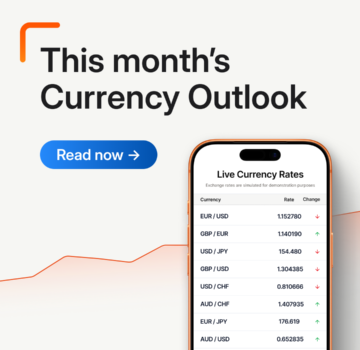A P-card, purchasing card or procurement card, is a company-issued charge card that allows employees to make business-related purchases. It’s a faster, more efficient alternative to traditional purchase orders and reimbursement processes, helping organisations simplify everyday buying, reduce paperwork, and maintain better control over spending.
The best P-cards go beyond basic purchasing. They offer features like real-time spend tracking, detailed transaction data, custom spend controls, and 2-way integration with your accounting or ERP systems. As companies scale, they look for tools that give finance teams more control without slowing down day-to-day operations, especially when managing global expenses or multi-location teams.
A P-card can also support international business by simplifying global payments. It allows teams to spend securely and efficiently, whether they’re purchasing locally or managing overseas suppliers. When paired with a global payments provider like OFX, P-cards can form a powerful part of your financial toolkit, streamlining operations while keeping costs and compliance in check.
In this article, we’ll take a closer look at how P-cards work, what features to look for in a provider, and how integrating with a global payments partner can help your business stay agile, efficient, and in control.
How do purchasing cards work?
P-Cards let employees make approved business purchases directly, without needing to go through the usual purchase order process. They’re especially useful for managing smaller, frequent transactions, things like office supplies, subscriptions, or minor services. What makes P-Cards particularly effective is the ability to customise controls, such as setting spending limits, restricting certain merchants, or capping monthly usage. Every transaction is automatically tracked and categorised, which makes expense reporting and reconciliation much simpler and faster.
A P-card is typically issued by a financial institution (like a bank or card provider), but it’s done on behalf of a business or organisation.
Here’s how it works in simple terms:
- A business applies for a P-card program through a financial provider (like a bank, corporate card provider, or vendors such as office supply retailers).
- The financial institution issues the cards under the business’s name.
- The company then distributes the cards to selected employees, setting rules, limits, and controls for how they’re used.
So while the card itself comes from the bank, the company manages how it’s used — including who gets one, how much they can spend, and what they can spend it on.
Is a P-card a debit card?
A P-Card isn’t a debit card, even though it might look like one. While debit cards draw funds straight from a bank account, P-Cards function more like credit cards, where the company pays the balance after the fact. However the balance is usually required to be paid in full each month. The key difference is control, P-Cards are designed specifically for business use, with built-in settings that help prevent misuse and ensure employees stick to purchasing policies. They’re a smarter, safer option for managing everyday business expenses without tying directly into a company’s bank account.
What is the difference between a corporate credit card, business credit card and a P-card?
While corporate credit cards, business credit cards, and purchase cards (P-cards) all help manage business expenses, they’re designed for different needs and come with varying levels of control, flexibility, and oversight. Choosing the right option, or a combination of tools, depends on how your organisation spends and what level of visibility and control you require.
- Corporate credit cards are typically issued to employees who travel frequently or entertain clients. They’re mainly used for travel and entertainment (T&E) expenses and come with higher spending limits and fewer restrictions. These cards are often linked to expense management systems and are usually assigned to middle or senior management.
- Business credit cards are similar to corporate cards but are usually geared toward smaller businesses or sole traders. They’re issued under the business name but function much like a personal credit card, with more general use across business expenses. They may lack the detailed controls and reporting features found in more enterprise-focused tools.
- Purchase cards (P-cards) are designed for everyday operational purchases, such as office supplies, maintenance items, or software subscriptions. Unlike credit cards, P-cards are charge cards, meaning the balance must be paid in full each month. They offer detailed transaction data, tight spending controls, and integration with procurement systems, making them ideal for high-volume, low-value transactions.
Both corporate cards and P-cards serve valuable roles, often working best when used together as part of a broader payment strategy.
What can you use a P-card for?
P-cards can be used for a wide range of business-related purchases that help keep things running smoothly. Common uses include:
- Office supplies, from stationery to electronics
- Travel expenses like flights, accommodation, and meals
- Entertainment costs, such as client meetings or staff hospitality
- Software, apps, and subscription services
- Training materials and professional development courses
- Small equipment or home-office purchases
- Vendor services like printing, catering, or event support
- Emergency purchases, including urgent repairs or last-minute supplies
P-cards aren’t just for businesses, either. Universities often provide them to staff or students for approved, tax-exempt purchases related to study or research. Government agencies also rely on P-cards to streamline buying day-to-day goods and services while staying within procurement policies.
A corporate multi-currency card that’s integrated with your business
Gain greater control and visibility by managing your domestic and international expenses and approvals all in one place.
Features to look for in a purchasing card
- Spend limits
Set limits by merchant, transaction amount, or spending period. - Receipt matching
Transactions are automatically categorised and linked to receipts for easier reconciliation. - Flexible usage
Covers a variety of expenses, including travel, subscriptions, training, and vendor services. - Spend reporting
Provides detailed, real-time insights into purchasing patterns and budget usage. - Policy compliance
Built-in controls ensure alignment with company policies and financial guidelines.
The benefits of using purchasing cards
Make purchases faster
Ensures teams have what they need, when they need it, enabling quick access to goods and services without the delays of traditional purchase orders. With spending controls already in place, staff can make decisions and purchases independently, without waiting on central approvals.
Control spending
Unlike traditional corporate cards, which can lead to issues like zombie spend (ongoing charges for unused services) or frivolous purchases, P-cards allow you to set granular controls, like spend limits per card, transaction categories, vendor or merchant restrictions, and approval workflows. This reduces the risk of unauthorised expenses and helps ensure every purchase aligns with policy.
Variety of uses
P-cards are designed to adapt to different roles and departments within a business, offering flexible controls without sacrificing oversight. Whether it’s a marketing team booking travel or facilities ordering supplies, employees can access the resources they need without jumping through hoops.
Saves you time
The best P-card offerings include receipt scanning and automatic matching tools, making expense reporting far less manual, and much faster at end of month. Traditional corporate credit cards often rely on manual reconciliation and reimbursement processes, which are time-consuming and prone to errors.
Saves you money
With centralised tracking and data-rich reporting, finance teams can see who’s spending what, identify overspending, and optimise purchasing across the business.
Built-in security
No need to share cards. Individual physical and virtual purchasing cards reduce the risk of fraud by avoiding shared card details and making it easy to track who spent what, where.
Types of purchasing cards
Purchasing cards are different from traditional corporate credit cards, offering businesses the ability to set specific spending limits and vendor restrictions. This targeted approach helps businesses align transactions with financial policies, reducing the risk of unauthorized or inconsistent spending. Additionally, P-Cards automate the expense management process, saving time and improving accuracy in financial reporting. There are several types of P-Cards, each offering distinct features to suit different business needs:
Single use cards
Single-use P-cards are designed for one-time transactions, offering added security for specific purchases. They are typically virtual cards, generated for a single purchase and then deactivated once the transaction is completed. The key benefits include:
- Enhanced security: Single-use cards can be set with pre-defined spending limits and merchant restrictions, reducing the risk of fraud.
- Customisable limits: The card can be tailored for one-time use, ensuring that it is only valid for the intended purchase.
- Ideal for irregular purchases: Single-use cards are perfect for transactions where a business needs flexibility without compromising security, such as making an emergency purchase or handling vendor payments outside of normal business channels.
Virtual cards
Virtual P-cards are digital cards that allow for secure online transactions. They are typically issued for specific purchases, providing businesses with enhanced control and fraud protection. Virtual cards can be used for:
- Targeted spending: Virtual cards can be set with specific spending limits, merchant restrictions, and expiry dates, ensuring that they are only used for the intended purpose.
- Security: These cards do not involve physical plastic, which reduces the risk of card theft or fraud.
- Integration with automation systems: Virtual cards can seamlessly integrate with financial systems, enabling automatic expense categorisation and reconciliation, saving time and improving accuracy in reporting.
Physical cards
Physical P-cards function much like traditional credit cards, but with the added benefit of being able to set and enforce specific spending controls. These cards are issued to employees for everyday purchases and come with features that enhance control over business expenses:
- Transaction control: Businesses can set spending limits and restrictions on where and how the card can be used, helping to enforce company policies.
- Broad applicability: Physical cards are ideal for in-person transactions and can be used for a variety of purchases, such as office supplies, travel expenses, or vendor payments.
- Integration with financial systems: Like virtual cards, physical P-Cards can also be integrated with automation tools, simplifying the process of tracking and reconciling expenses.
How to choose a P-card provider: key features to look for
A great P-card provider can make life easier for your finance team while giving you more control, visibility, and flexibility. Whether you’re managing a growing team or streamlining procurement, here are the top features to keep in mind:
Unlimited physical and virtual cards
Avoid the hassle of card limits and extra fees. The best P-card providers offer unlimited physical and virtual cards, so every team member can have access and you never have to share cards. Virtual cards are especially handy for one-off or specific purchases, adding an extra layer of security and control.
Clear spend limits and custom controls
You should be able to set spending limits by card, merchant, category, or even time period. This not only ensures employees stay within policy, it also removes the need for purchase orders or reimbursement claims. Look for customisation options that let you control user permissions and approved vendors.
Real-time visibility and control
A top-tier P-card program gives you a live view of spending across the business. Real-time tracking means you can spot unauthorised transactions immediately, stay on budget, and keep your compliance tight. You’ll also want detailed analytics to identify trends and inform smarter decision-making.
Vendor approvals and restrictions
Unlike traditional corporate cards, modern P-card solutions let you approve or block specific vendors. That way, team members can only spend company money where it’s allowed, reducing the risk of off-policy purchases and simplifying procurement approvals.
Seamless integration with accounting systems
Your P-card platform should play nicely with your existing financial software, whether it’s Xero, Employee Hero, QuickBooks, or another tool. Direct integration saves hours of manual data entry and makes reconciliation easier.
Automatic receipt matching
One of the biggest pain points in expense management is chasing receipts. A good P-card provider will include automatic receipt capture, just snap a photo, and the system matches it to the transaction, categorises the expense, and updates your records. It’s a simple way to speed up month-end and stay audit-ready.
Strong security features
Finally, security matters. Look for providers that offer robust fraud protection and custom card controls. Create unique card details with virtual cards so you don’t have to share cards between employees or across multiple websites. These tools help safeguard your organisation’s funds while keeping spending flexible and efficient.
Choosing the right P-card provider is about more than just payment, it’s about empowering your team, keeping costs under control, and freeing up time for higher-value work.
Why are Canadian businesses choosing a P-card alternative that can do more?
Today’s businesses need more than just a card to make purchases, they need a solution that supports smarter spending, stronger controls, and simpler processes. That’s why many Canadian businesses are moving to P-card alternatives that offer more flexibility, visibility, and support.
Here’s what to look for when choosing a modern P-card solution:
Stronger security and fraud protection
Look for a provider that prioritises security with features like virtual cards, real-time alerts, and built-in fraud detection tools to help keep sensitive financial data secure and prevent unauthorised spending.
Seamless integration with your systems
Your P-card platform should work effortlessly with your existing financial systems and workflows. Whether you use Xero, Employee Hero, Quickbooks, or another platform, smooth integration saves time and reduces manual work.
User-friendly experience
Choose a system that’s easy to navigate for everyone. An intuitive interface helps employees feel confident using their cards, leading to better compliance and fewer errors.
Training and support that’s actually helpful
A good provider won’t just hand you the tools, they’ll show you how to use them. Look for one that offers onboarding, training sessions, and easy-to-access support to help your team get the most out of the platform.
A true partnership, not just a product
The right provider will support you long after setup, working with you to optimise your program, adapt to business changes, and offer strategic insights to help you reach your goals.More and more Aussie businesses are saying goodbye to rigid, outdated P-cards—and choosing flexible solutions that grow with them, support their teams, and help them stay in control of company spending.
P-Card FAQs
What is a P-Card?
A P-Card (purchasing card) is a financial tool designed to streamline and simplify business expenses. It enables employees to make business-related purchases quickly, bypassing traditional processes like purchase orders, while still maintaining oversight and control.
Who can benefit from using P-Cards?
P-Cards can be beneficial for a wide range of industries, including startups, large enterprises, and sectors like higher education, municipal government, and healthcare. Organisations with varied purchasing needs can particularly benefit from P-Cards, offering flexibility and responsiveness in managing procurement activities.
What are the main advantages of using P-Cards?
- Efficient financial oversight: P-Cards simplify the tracking and organisation of expenses, reducing the need for manual reconciliation.
- Enhanced auditing: Detailed transaction insights improve the auditing process and support thorough financial evaluations.
- Streamlined expense management: Financial teams save time on administrative tasks, leading to quicker and more accurate financial record-keeping.
Are there disadvantages to using a P-card?
Here are a few things to keep in mind before choosing to use a P card:
- Unclear rules – If your team doesn’t have clear guidelines on what’s OK to buy, people might use the card incorrectly or inconsistently.
- Poor oversight – Without proper checks in place, there’s a higher chance of overspending or missing unauthorised transactions.
- Risk of misuse – Sometimes cards are given to staff who don’t actually have permission to make purchases, which can lead to mistakes or misuse.
- Cards not cancelled on time – If someone leaves the business or changes roles, cards aren’t always cancelled straight away, which can be a security risk.
- Harder to keep track of spending – If there are heaps of small purchases, it can be tricky for the finance team to match up transactions and manage cash flow easily.
- Not all suppliers accept them – Some suppliers don’t like card payments because of the fees, so you might still need other payment options.
How can I prevent misuse of P-Cards?
To prevent misuse, businesses can:
- Educate cardholders on proper use and the importance of adhering to established guidelines.
- Conduct regular reviews and audits of P-Card transactions.
- Implement strong monitoring and control systems to quickly identify and address any irregularities.
How do P-Cards contribute to better financial management?
P-Cards provide businesses with greater visibility into spending patterns and help streamline the reconciliation process. They enable faster, more accurate financial reporting, fostering a more organized and transparent expense management strategy.
How do I get started with P-Cards?
Getting started with P-Cards involves selecting a trusted provider, setting clear policies for usage, and ensuring your employees are properly trained. Partnering with a provider like OFX can help you implement a smooth and effective company card program that aligns with your business goals.
IMPORTANT: The contents of this blog do not constitute financial advice and are provided for general information purposes only without taking into account the investment objectives, financial situation and particular needs of any particular person. UKForex Limited (trading as “OFX”) and its affiliates make no recommendation as to the merits of any financial strategy or product referred to in the blog. OFX makes no warranty, express or implied, concerning the suitability, completeness, quality or exactness of the information and models provided in this blog.



